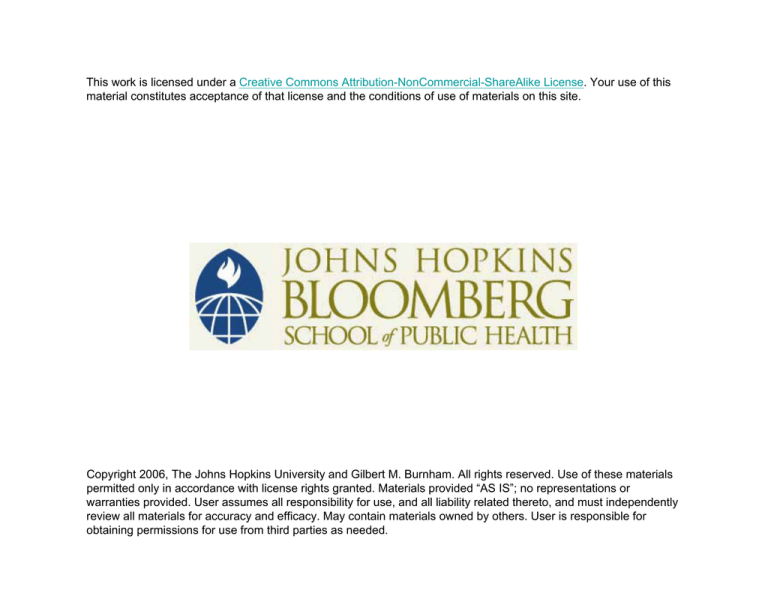
This work is licensed under a Creative Commons Attribution-NonCommercial-ShareAlike License. Your use of this
material constitutes acceptance of that license and the conditions of use of materials on this site.
Copyright 2006, The Johns Hopkins University and Gilbert M. Burnham. All rights reserved. Use of these materials
permitted only in accordance with license rights granted. Materials provided “AS IS”; no representations or
warranties provided. User assumes all responsibility for use, and all liability related thereto, and must independently
review all materials for accuracy and efficacy. May contain materials owned by others. User is responsible for
obtaining permissions for use from third parties as needed.
Assessing Health Needs
Gilbert Burnham, MD, PhD
Johns Hopkins University
Section A
What Are Assessments?
Purpose of Assessments
To identify what people’s needs are
To define baseline status for future
comparison
To determine what changes have occurred
as a result of the program
To identify program weaknesses or gaps
3
Rapid Assessments
Similar to planning other health activities
Pace is accelerated in the emergency
Needs are often more urgent
– May differ from those before flight
Continued
4
Rapid Assessments
Selecting priorities may be difficult
– Consider consequences of inaction
Identify critical needs, then repeat
assessment week later for less urgent needs
5
Assessment Checklists
Many checklists exist
– For example, OFDA’s Field Officer’s Guide
(FOG) download at www.info.usaid.gov
Need to understand how they are used
Are not a substitute for understanding the
environment
6
Possible Assessment Questions
Why have things happened?
– How did things get the way they are now?
What is likely to happen next?
– Are people ready to go home?
– Are more people coming?
– Is cholera likely to break out?
– Are there any possible outbreaks of
hostility?
Continued
7
Possible Assessment Questions
What is the situation in the host
country?
– What are the common local diseases?
– What kind of support is available?
– Is the host population compatible?
– How will things develop?
8
Basic Planning Cycle
Not unique to refugee situations
Provides a basic approach to address needs
that have been identified
9
Basic Planning Cycle: Step 1
Assessment
Gather data
needed to design
programs
10
Basic Planning Cycle: Step 2
Identify
Problems
Determine what
are the major
problems
11
Basic Planning Cycle: Step 3
What are the
most critical
problems?
Consequences of
not addressing
them?
Set
Priorities
12
Basic Planning Cycle: Step 4
Are there other
ways of dealing
with problems?
Consider
Alternatives
13
Basic Planning Cycle: Step 5
Choose
Solutions
Example: CHW
program,
expand local
services
14
Basic Planning Cycle: Step 6
Take
Action
Implement
Program
15
Basic Planning Cycle
Assessment
Identify
Problems
Take
Action
Choose
Solutions
Set
Priorities
Consider
Alternatives
16
Section B
Conducting Assessments
Conducting the Assessment
Assessment is the basis for program
development
– Poor assessments lead to weak programs
Continued
18
Conducting the Assessment
Basic principle is to determine the
following:
– What are the needs now?
– What are the likely future needs?
– What resources are available now?
– What resources will be needed?
19
Thinking in a Systematic Way
What has happened?
– What is the impact on the community?
– What is the impact on the household?
– What is the impact on the vulnerable
individuals/groups?
How is the situation likely to change?
What is the political environment?
Continued
20
Assess Specific Problems
Are there problems with shelter and
clothing?
Are there problems with water for cooking,
washing, bathing?
Are there problems with food and fuel?
Are there problems with disease threats?
How is the community coping with illness?
Continued
21
Assess Ways of Assisting
Target Groups
Are vulnerable populations in danger?
– How can protection be organized?
What must be done immediately to ensure
survival?
Continued
22
Assess Ways of Assisting
Target Groups
What must be done immediately to ensure
survival?
– How can this assistance be delivered?
– What are the target groups?
23
Assess Local Resources
How can displaced people help themselves?
– What are people doing now?
How can displaced people help themselves?
– What unmet needs are there?
Continued
24
Assess Local Resources
How much assistance can the host
government provide?
– What are the government policies that will
affect assistance?
25
Assess the Host Population
How have the refugees affected the local
population?
How will assistance programs affect the host
populations?
Is there poaching of health workers by high
salaries?
26
Assess the Host Population
Set Priorities and Objectives
Are local services and drug supplies
overwhelmed?
What are the needs of the host population?
27
Assess the Host Population
Does the host have common unmet needs
that can be addressed?
28
Developing an
Assistance Program
Setting of mission
– Why are we here?
Identification of needs
– Should be specific and quantified
wherever possible
– Needs will serve as basis for monitoring
program impact
29
Set Priorities and Objectives
Selecting priorities
– What can we do?
– What do we want to do?
Clear objective as basis of strong programs
– Objectives must be measurable
– Indicators for each must be easily
assessed
Have alternatives to program design
30
Define Strategies and Alternatives
Strategies to implement objectives
– How are we going to do it?
– Clear series of tasks set out
– Identify required resources
Consider alternatives in program design
31
Program Monitoring
and Evaluation
Monitoring system needed to assess progress
towards objectives
Evaluation based on objectives
– Are the objectives the correct ones?
– Have they been reached?
– Is there clear evidence of impact?
Continued
32
Program Monitoring
and Evaluation
How will the program be altered based on
this information?
Establish evaluation criteria right from the
beginning of the program
Determine the feedback mechanisms for
informing the health workers and community
who participated in evaluation process
33

